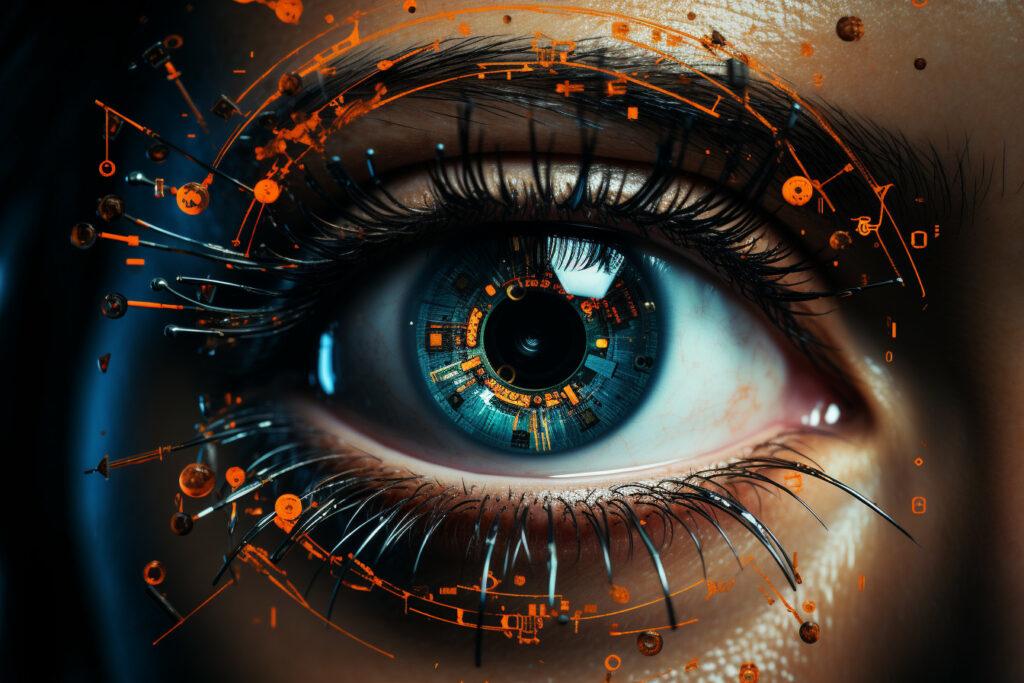Eyes on Security – Exploring Iris Recognition, Retinal Scanning and Other Eye-Based Biometrics in IoT

Eye-Based Biometric Methods
In addition to iris recognition and retinal scanning, other eye-based biometric methods might be explored for IoT security:
- Conjunctival Vasculature Recognition – This method analyzes the blood vessels on the eye’s white part, known as the conjunctiva. It can be used as an additional security measure but is still in the experimental phase.
- Eye Movement Tracking – Monitoring and analyzing an individual’s eye movement can be used for identity verification. However, it is less reliable as a standalone method and might be used in conjunction with other techniques.
- Scleral Recognition – The sclera, or white part of the eye, has unique patterns that can be analyzed for identification. This method is less common and requires further research and development.
Iris Recognition and Comparison with Retinal Scanning
Retinal scanning is another eye-based biometric method that analyzes the unique pattern of blood vessels in the retina at the back of the eye. It requires close proximity to the scanning device and is known for its high accuracy.
Comparison Between Retinal Scanning and Iris Recognition
- Cost – Retinal scanning equipment tends to be more expensive than iris recognition systems. Also, retinal scanners often require more maintenance, adding to the overall cost.
- Reliability – Both retinal scanning and iris recognition are highly reliable, but retinal scanning may be affected by certain medical conditions that change the blood vessels’ pattern in the retina.
- Ease of Use – Iris recognition is generally considered more user-friendly, as retinal scanning requires the user to be close to the scanner, which can be uncomfortable.
- Security – Both methods provide high security, but retinal scanning is less susceptible to spoofing attempts compared to iris recognition.
Introduction to Iris Recognition
Iris recognition is a biometric technology that identifies individuals based on the unique patterns found in their irises. Unlike fingerprints, which require physical contact, iris recognition relies on imaging technology to capture a detailed picture of the iris.
How Iris Recognition Compares to Other Biometric Methods
Compared to other biometric methods like fingerprinting or facial recognition, iris recognition offers several advantages. It’s non-invasive, offers a high degree of accuracy, and is difficult to fool. This makes it an attractive option for various security applications.
Technical Aspects of Iris Recognition
The Technology and Processes Behind Iris Recognition
Iris recognition works by capturing a high-resolution image of a person’s eye using specialized cameras. The system then analyzes the unique patterns in the iris, converting them into a digital code. This code is used to compare and verify the individual’s identity.
Security Features Like Encryption and Anti-Spoofing Mechanisms
Security is paramount in iris recognition. Advanced encryption ensures that the data remains confidential, while anti-spoofing mechanisms detect attempts to trick the system using fake irises or other deceptive methods.
Possible Limitations and Drawbacks of the Technology
Although highly effective, iris recognition is not without challenges. Factors such as lighting, camera quality, and user cooperation can affect accuracy. Moreover, the cost of specialized equipment may be a barrier for some applications.
Integration of Iris Recognition with IoT
How Iris Recognition Can Be Applied to IoT Devices
Iris recognition can be integrated into IoT devices for authentication purposes. By using a person’s iris as a unique identifier, IoT devices can provide secure access to sensitive information or control specific functions, enhancing overall security.
Challenges and Considerations in Implementing Iris Recognition in IoT
Implementation within the IoT ecosystem can be complex. It requires careful consideration of hardware compatibility, data transmission, user experience, and privacy concerns. The interconnected nature of IoT devices adds layers of complexity that must be thoughtfully navigated.
Benefits of Using Iris Recognition in IoT Security
Enhancing Security and Privacy in IoT Through Iris Recognition
Iris recognition offers a highly secure method for authenticating users within an IoT network. Since the iris is unique to each individual, it provides a robust defense against unauthorized access, thereby enhancing both security and privacy.
Real-Life Examples or Case Studies Showcasing Successful Implementations
Several industries have successfully implemented iris recognition in IoT applications. From smart homes using iris scanning for access control to healthcare facilities utilizing it for patient identification, the technology is proving its worth in real-world scenarios.
Ethical and Legal Considerations
Privacy Concerns Related to Iris Recognition
While offering enhanced security, iris recognition also raises privacy concerns. Storing and handling biometric data must be done with the utmost care, adhering to relevant legal and ethical guidelines to ensure individuals’ privacy rights are protected.
Compliance with Regulations and Standards
Compliance with legal requirements and international standards is essential when implementing iris recognition in IoT. Regulations such as GDPR govern how biometric data must be handled, and non-compliance could lead to legal challenges.
Future Trends and Innovations in Iris Recognition for IoT
Potential Advancements and Innovations in the Technology
The field of iris recognition is continuously evolving. Future advancements may include faster recognition algorithms, integration with other biometric techniques, or the development of more compact and affordable hardware. These innovations could further extend the application of iris recognition within the IoT domain.
How Future Trends May Shape the Use of Iris Recognition in IoT Security
Emerging technologies and industry shifts may significantly impact how iris recognition is applied in IoT security. Increased emphasis on privacy, new regulations, or advancements in artificial intelligence could shape future implementations and applications.
Comparative Analysis
Comparing Iris Recognition with Other Biometric Techniques in the Context of IoT
When comparing iris recognition to other biometric techniques like fingerprints or facial recognition, several factors come into play. Iris recognition offers unique advantages, such as non-contact operation and high accuracy. However, it may also face challenges like higher costs or sensitivity to environmental conditions.
Strengths, Weaknesses, and Unique Features of Iris Recognition
Iris recognition’s strengths lie in its uniqueness, reliability, and non-invasiveness. Its weaknesses might include its dependence on high-quality equipment and susceptibility to specific spoofing attempts. Understanding these aspects helps in choosing the right biometric method for specific IoT applications.
Practical Guidelines for Implementation
A Step-by-Step Guide or Best Practices for Integrating Iris Recognition into IoT Devices
Implementing iris recognition in IoT requires careful planning and adherence to best practices. Considerations should include selecting the right hardware, ensuring proper encryption, considering user experience, and following legal compliance. Collaboration with experts in both iris recognition and IoT is crucial for successful integration.
Global Perspective on Iris Recognition in IoT
Different regions or industries may adopt iris recognition in IoT at varying rates. Cultural acceptance, regulatory environment, and industry needs play a part in how this technology is embraced globally. Understanding these factors is essential for international implementations.
Conclusion
The human eye offers various avenues for biometric identification, from the well-established techniques of iris recognition and retinal scanning to emerging methods like conjunctival vasculature recognition. Each method brings its unique blend of cost, reliability, ease of use, and security.
Iris recognition and retinal scanning, in particular, represent two of the most potent eye-based biometric techniques. While they share similarities in accuracy and security, they differ in aspects like cost, user experience, and susceptibility to certain challenges.
Exploring these diverse eye-based biometrics illuminates the rich potential for enhancing IoT security. It emphasizes the importance of considering various factors to choose the most appropriate method for specific applications and scenarios.
As the landscape of IoT and biometrics continues to evolve, the integration of these eye-based technologies promises a more secure and personalized experience. Future innovations will likely bring new dimensions to this exciting field, shaping the next frontier of identity verification within a connected world.










